How artificial is an artificial swarm?
Synopsis: Artificial swarms are created during swarm control. Their size and composition are very different from natural swarms. Does this matter?
Introduction
Swarm prevention is applied to delay, or potentially stop altogether, a colony making swarm preparations.
Space is made in the brood box by replacing frames of stores with drawn comb or foundation, additional supers are added and/or a frame or two of brood and bees are removed to make up a nuc (supplemented with a spare queen or a queen cell from elsewhere).
However, swarm preparations are usually just postponed and not terminated. In time the colony outgrows the space available and starts producing queen cells. Swarm control must then be applied or it is almost inevitable that the colony will swarm.
Unless you have spare queens aplenty, or are an aficionado of the Demaree method of swarm control, for the majority of beekeepers, swarm control means conducting an ‘artificial swarm’.
An artificial swarm is a colony manipulation that broadly mimics a natural swarm by the separation of the queen from the developing queen cells, via the production of two viable colonies. These can be further expanded into honey production colonies or re-united to leave a single large colony headed by a new queen.
- viable … meaning that the two colonies produced during the artificial swarm either have, or will produce, a queen and workers with the capability to develop into a self-sufficient colony.
- broadly mimics … because the artificial swarm is actually very different in size and composition from a natural swarm.
Before discussing how artificial an artificial swarm actually is we first need to consider the size and composition of a natural swarm.
But, before that, a quick recap on the three – or it is four? – functional components of the colony that are manipulated during swarm control.
Viability
In previous posts I’ve used the following diagram to illustrate the concept of colony viability and swarm control.
A queen on her own is not ‘viable’. She cannot draw comb, or forage or do anything much other than lay eggs. She needs the support of a population of workers that do all these things for her.
Similarly, workers without a queen have no long-term future. A terminally queenless colony is just that … terminal. Some develop laying workers in a (probably) futile attempt to pass their genes on to a subsequent generation.
However, workers and a queen, even with no comb or brood, can develop into a full colony. They’ll draw comb, forage, support the queen and defend the colony. This is exactly what constitutes a package of bees when purchased.
Additionally, the combination of workers and developing brood – specifically eggs and young larvae – is also potentially viable as the workers can rear a young larva into a new queen, so ensuring the survival of the colony.
The diagram above was drawn with the most common artificial swarm technique – the Pagden artificial swarm – in mind. Most common as it seems to be the method that is usually described in beekeeping books for beginners, and is the approach typically taught in winter courses for new beekeepers.
So, the three components are; the queen, the developing brood (assuming it contains eggs and young larvae) and the workers.
However, for the purpose of this post I’m going to further divide the workers into two overlapping groups – hive bees and foragers – so generating a fourth component to consider in swarms and artificial swarms.
Hive bees and foragers
A newly emerged worker initially remains in the hive, cleaning cells and conducting other ‘in hive’ activities. After 7-10 days the bee – usually over a period of several days – then embarks on a number of orientation flights that familiarise her with the environment and local geography. After that she becomes a forager (collecting water, pollen or nectar).
Bees that have undertaken orientation flights know where the hive is and so can return. Those that have not, don’t.
If you’ve ever accidentally dropped a frame a few metres from the hive it was removed from you’ll have seen the flying bees return to the hive, leaving behind a sad little group of disorientated young bees that usually cluster together on the ground.
The distinction between hive bees and foragers is not absolute. You can divide the adult life of a worker into three distinct periods of activity – ‘in hive’, orientation flights and foraging.
This is a little more meaningful than flying bees and non-flying bees. Bees going on orientation flights are, by definition, flying … but they’re not foragers.
I’m going to write in the future about the lifespan of workers. Like WWI fighter pilots, the attrition rate of foragers is extremely high (~9% per hour!) so they tend not to live very long.
The swarm fraction
When a colony swarms the queen leaves with a proportion of the worker population. This proportion is termed the ‘swarm fraction’.
For example, a swarm fraction of 0.5 means that the swarm contains half of all the workers. A small swarm fraction (e.g. 0.1) would mean that the survival chances of the swarm were limited. Conversely, if the swarm fraction was very large (e.g. 0.99) so few bees would remain in the original nest that it would not be able to defend itself and the goal of swarming (which is reproduction) would not be achieved as the original colony would be doomed.
Several researchers have determined the swarm fraction for natural swarms. You can do this by waiting until a colony swarms and then weighing (or counting if you are patient) the workers in the swarm and the original nest.
Alternatively – and to test survival of swarms with different swarm fractions – you can split a colony (e.g. 90/10, 50/50, 30/70 or 10/90) and monitor the survival of swarms overwinter.
You can even calculate a predicted swarm fraction from the cumulative inclusive fitness of the mother-queen and daughter-queen colonies (Rangel et al., 2013) … and if that doesn’t make sense don’t worry, I’ll only summarise results from empirical studies.
Swarm fractions ranging from 0.4 to 0.8 are reported in the literature, with some variation depending upon the size of the original colony. However, the most complete study is probably from Rangel and Seeley (2012) who report a swarm fraction of 0.75, a figure in agreement with several other studies.
75% of the worker bee population leave with the queen in a natural swarm.
Think about your artificial swarms … do they contain 75% of the workers from the hive?
Probably not.
What’s in the swarm?
If you mark emerging workers with coloured paint on the thorax or abdomen, using a different colour for successive weeks, you can retrospectively determine the age profile of bees in the colony … or, after swarming, in the swarm.
David Gilley (1998) did this in his studies of the age of scout bees – these are the bees that find and select new nest sites and lead the swarm to the new site. In addition to ageing the scout bees (they are a bit younger than the median age of foragers since you asked) he also showed that the median age of workers in a swarm was less than in the hive immediately prior to swarming.
Swarms predominantly contain younger bees.
Gilley monitored four prime swarms and demonstrated that the median age of the workers in the swarm were 9, 9, 12 and 3 (average 8 and a bit) days younger (o in the graph) than that in the pre-swarmed colony (e in the graph). This means that bees do not randomly partition between the swarm and the original colony; more young bees leave with the swarm.
So, to summarise, a natural swarm contains 75% of the worker population in a colony and the median age of those bees is over a week younger than that of the worker population of the swarming colony.
Considering the average lifespan of workers (23-41 days, of which only ~8 days are spent foraging) it is certain that a swarm contains large numbers of workers that are not foragers, and many that have yet to go on their orientation flights.
Artificial swarms
I’m going to discuss two artificial swarm methods, together with my favoured ‘nucleus method’ for swarm control. The purpose here is to highlight the similarities and differences primarily of the age profile of the bees that accompany the old queen (the mother-queen colony), or that remain with the developing queen cells (the daughter-queen colony). I’ll also briefly mention the swarm fraction, but a fuller examination of this will need to wait until a future post on the longevity of workers.
Pagden
The Pagden method of swarm control has been described previously. I’m not going to repeat it other than to summarise the key points. The original hive is moved aside, the queen found and placed in a new hive on the original site. She is subsequently joined by the flying bees (foragers and those that have been on orientation flights). In contrast, the workers that have yet to leave the hive remain with the developing queen cells. Typically this latter hive is moved to a new location.
In the Pagden method of swarm control the mother-queen ends up with the older worker bees.
Taranov
I’ve not discussed this method before and have never used it. I’ve intended to, but circumstances have contrived against me … perhaps next year.
The colony with queen cells (1) is shaken out onto a sheet covering a ramp that leads to the hive entrance (2). Importantly the ramp stops about 10 cm short of the entrance, leaving a gap for the bees to cross. In addition, a loop of carpet or hessian is stapled under the projecting lip of the ramp.
The bees walk up the ramp towards the hive. The flying bees may fly directly or walk to and then fly across the narrow gap when they reach the end of the ramp. In contrast, the queen and the young, non-flying, bees do not cross the gap but instead cluster underneath the lip of the ramp, clinging to the carpet (3).
Therefore, in the Taranov method of swarm control the mother-queen ends up with the younger worker bees.
The nucleus method
Again, this method has been described in gruesome detail before. It’s my favoured method of swarm control, uses little equipment and – performed correctly – is 100% successful in my experience.
However, it’s not really an artificial swarm.
The mother-queen is moved to a nucleus box together with a frame or two of emerging brood and adhering bees. This box is usually moved away – metres or miles {{1}} – and the remaining bees allowed to rear the daughter-queen.
A picture is worth a 1000 words
Except when it’s drawn by me.
Here’s a cartoon illustrating the Pagden and Taranov artificial swarming methods together with the nucleus method of swarm control.
Other than the smaller size of the newly created colony in the nuc I’ve not attempted to illustrate the differences in worker bee numbers in the methods shown. Based upon the age of first flight and the attrition rate of flying bees, the hive bees and those on orientation flights significantly outnumber foragers though the exact proportions depend upon how the bees on orientation flights partition.
The Pagden and Taranov methods produce very different results. In the former the mother-queen ends up with the older workers, in the latter she ends up with the younger (and likely, youngest) workers.
In contrast, the nucleus method results in a mixed population of workers with the mother-queen. Furthermore, the subsequent location of the newly created nuc probably has a significant influence on the worker population.
- if left in the same apiary many of the flying bees will return to the original hive, so depleting the nuc of workers. It may be necessary to supplement the colony with additional workers (by shaking in a frame or two of bees). This will result in the median age of workers in the nuc being reduced.
- if the nuc is moved to a distant apiary the worker population will remain broadly similar to when it was made (other than the bees ageing and new brood emerging of course).
Does any of this matter?
Probably not.
Worker bees exhibit temporal polyethism meaning they have age-related duties in the colony; comb cleaning, nectar processing, building comb, guarding, foraging etc.
However, they also exhibit plasticity in this behaviour. If there are too few foragers in the worker population some young bees ‘age’ faster and become foragers. Conversely, if the worker population is predominantly old (such as during a Pagden artificial swarm) then some foragers ‘regress’ to comb cleaning and nectar processing roles.
There are probably limits to this plasticity. For example, a recent paper suggests that both the season and forage availability may influence the sensitivity of the colony to large depletions of worker bee numbers (Lemanski et al., 2020).
If the limits to this plasticity are reached then the expansion of the colony – whether mother-queen or daughter-queen – will be restricted, potentially delaying colonies becoming strong enough for honey production or for successful overwintering.
However, just because it might not matter doesn’t make it uninteresting.
When we create an artificial swarm during swarm control its composition is very different from a real swarm.
As I’ve commented before, there are many different ways of achieving the same thing in beekeeping. With the exception of any method that involves ‘brood and a half’ {{2}} all are probably equally valid.
Advantages and disadvantages of the Taranov method
Of the methods mentioned, Taranov swarm control appears to be more similar to natural swarming in that the worker bees remaining with the mother-queen are younger (similar, but certainly not identical). Likewise, the older bees remain with the developing brood and queen cells.
I can think of advantages to this reorganisation of the colony:
- the young bees should live longer and so be available to rear brood from eggs laid by the mother-queen. Remember that this colony will not produce new brood for at least 21 days after swarming.
- the population of older bees with the developing daughter-queen will very soon be supplemented with newly emerging worker brood.
However, it’s worth noting that employing this method of swarm control requires additional equipment (the Taranov board/ramp), space around the hive being artificially swarmed and – as a consequence of shaking all the bees out onto a sheet – is likely to be a lot more disruptive to colony activity.
It’s also (obviously) weather-dependent. It’s not something I’d want to attempt on a cool or wet day whereas I’ll happily make up a nuc if the weather is poor.
I’m not recommending the Taranov method but it’s interesting to compare and contrast it to the much more widely used Pagden method.
After a fortnight of very low temperatures and settled weather it’s now warming fast and there’s a deep low pressure system whirling in from the west. My colonies will probably be starting to rear new brood and – in a few months – I’ll need to do some swarm control on them.
I want to be prepared …
Notes
Swarms have a disproportionately high Varroa load because they predominantly contain young bees. Be aware of this and treat if appropriate. Treat in the first week before capped brood is present.
Don’t use the descriptions of swarm control methods above as guidance. I’ve only mentioned the key events relating to swarm partitioning and omitted a number of important features needed to make them work.
The comment about brood and a half was my personal view … don’t bother commenting to try and convince me otherwise.
References
Gilley, D. (1998) The identity of nest-site scouts in honey bee swarms. Apidologie 29: 229–240 https://hal.science/hal-00891490.
Lemanski, N.J., Bansal, S., and Fefferman, N.H. (2020) The sensitivity of a honeybee colony to worker mortality depends on season and resource availability. BMC Evol Biol 20: 139 https://doi.org/10.1186/s12862-020-01706-4.
Rangel, J., Reeve, H.K., and Seeley, T.D. (2013) Optimal colony fissioning in social insects: testing an inclusive fitness model with honey bees. Insect Soc 60: 445–452 https://doi.org/10.1007/s00040-013-0309-3.
Rangel, J., and Seeley, T.D. (2012) Colony fissioning in honey bees: size and significance of the swarm fraction. Insect Soc 59: 453–462 https://doi.org/10.1007/s00040-012-0239-5.
{{1}}: To confusingly mix units of distance for alliterative emphasis.
{{2}}: A recipe for madness …

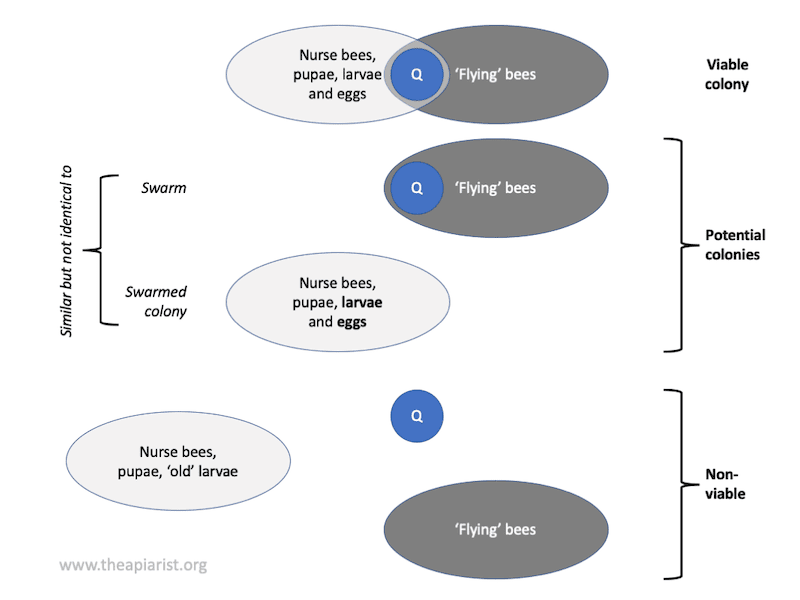
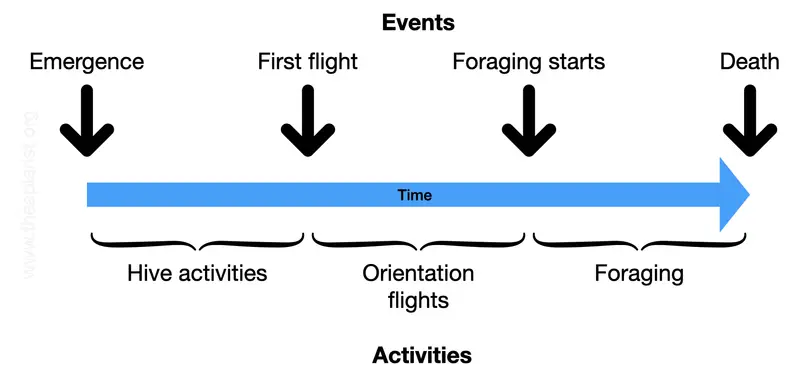
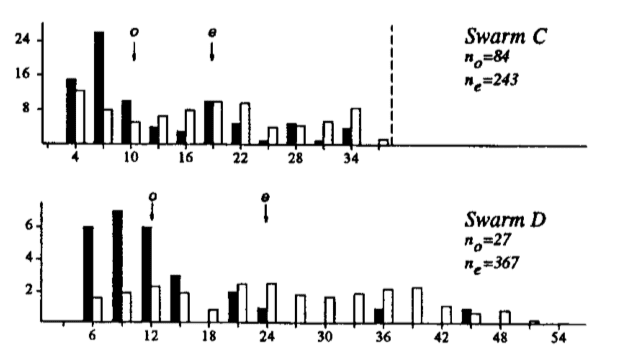
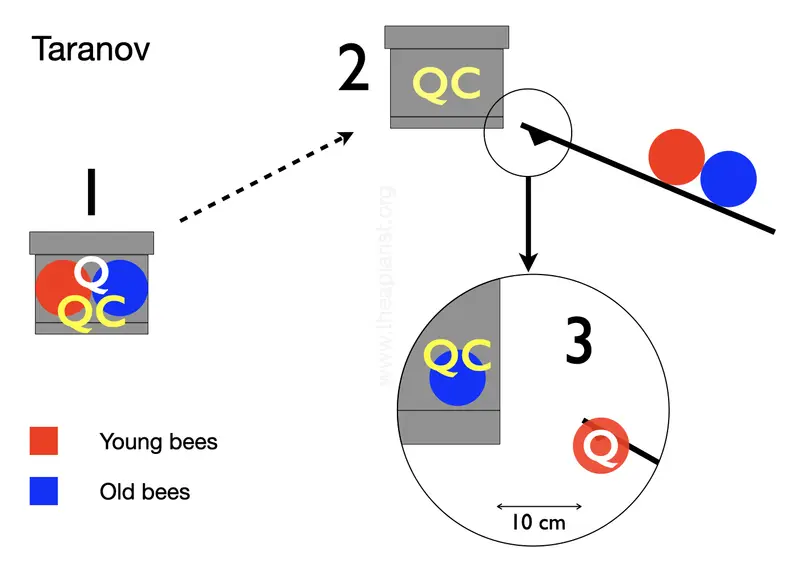
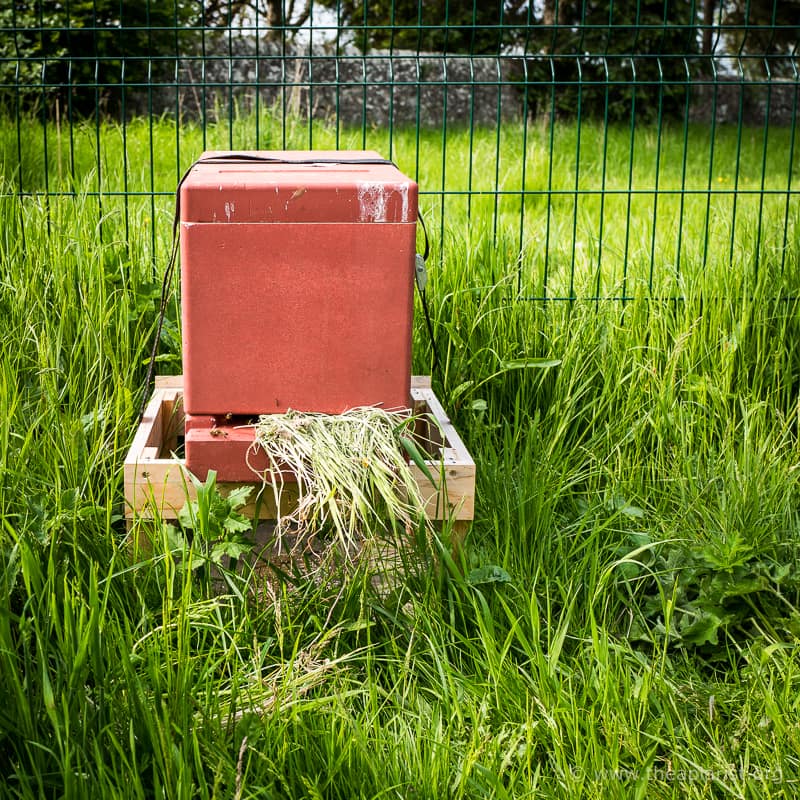
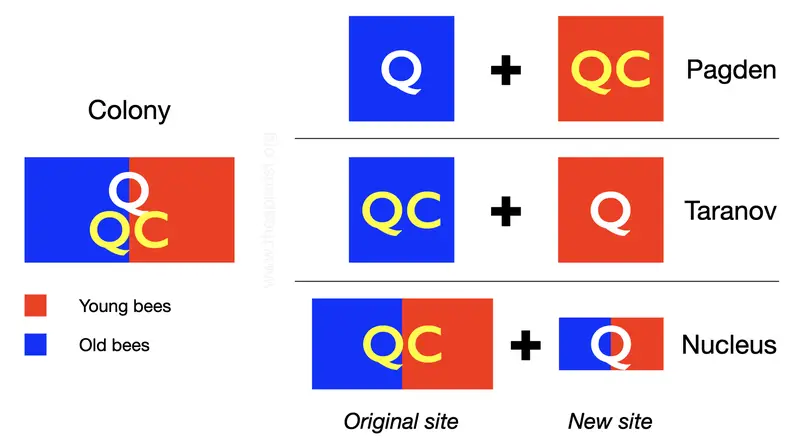

Join the discussion ...